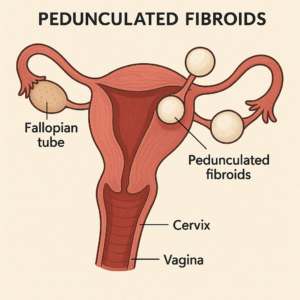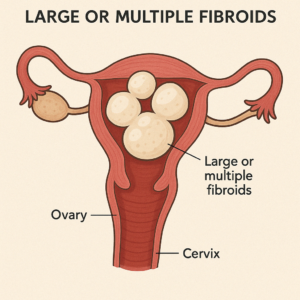At Eva IVF & Women’s Centre, we understand how uterine fibroids can affect a woman’s fertility, menstrual health, and quality of life. If you’re struggling with heavy periods, pelvic pain, or difficulty conceiving due to fibroids, a Laparoscopic Myomectomy offers a minimally invasive solution to remove fibroids while preserving your uterus.
This page is specially created for women seeking fertility-preserving fibroid surgery. We’ll walk you through what Laparoscopic Myomectomy is, who it’s for, the surgical process, success outcomes, and recovery, so you can move forward with clarity and confidence.
What is Laparoscopic Myomectomy?
Laparoscopic Myomectomy is a minimally invasive surgical procedure that involves removing fibroids (also called myomas) from the uterus through small abdominal incisions. Unlike a hysterectomy, this surgery preserves the uterus, making it ideal for women who wish to conceive in the future.
Fibroids are non-cancerous tumors that can grow inside, on, or within the wall of the uterus, causing symptoms like heavy menstrual bleeding, pain, pressure, and infertility.
💡 With laparoscopic surgery, you can expect less pain, quicker recovery, and minimal scarring compared to open surgery.

Who Should Consider Laparoscopic Myomectomy?

This procedure is ideal for women who:
✔ Have symptomatic fibroids (e.g., heavy periods, pelvic pressure, anemia)
✔ Have submucosal, intramural, or pedunculated fibroids affecting fertility or pregnancy
✔ Plan to conceive in the future and wish to preserve the uterus
✔ Have recurrent pregnancy loss due to fibroids distorting the uterine cavity
✔ Have been advised fibroid removal before IVF or fertility treatments
💡 Women with multiple, large, or deeply embedded fibroids may still be candidates depending on location and fertility goals.
How is Laparoscopic Myomectomy Performed?
1. Pre-Surgical Evaluation
✔ Hormonal tests and blood work
✔ Review of fertility plans and customized surgical strategy
2. Procedure Under General Anesthesia
✔ A laparoscope (camera) and instruments are inserted to view and access the uterus
3. Fibroid Removal
✔ The uterine wall is sutured to restore its shape and function
✔ In some cases, a device called a morcellator is used to remove larger fibroids in fragments
4. Recovery
✔ Patients usually return home the same day or within 24 hours
💡 Our surgical team ensures meticulous closure of the uterus to maintain its strength for future pregnancies.
Types of Fibroids Removed via Laparoscopic Myomectomy




💡 For submucosal fibroids (inside the uterine cavity), a hysteroscopic approach may be more appropriate.
Benefits of Laparoscopic Myomectomy
🌟 Preserves the Uterus – Ideal for women planning pregnancy
🌟 Minimally Invasive – Smaller cuts, less pain, and faster healing
🌟 Shorter Hospital Stay – Most patients go home within 24 hours
🌟 Quicker Return to Normal Activities – Resume work within 7–10 days
🌟 Lower Risk of Adhesions & Infections Compared to open surgery
🌟 Improves Fertility and Reduces Miscarriage Risk
💡 A personalized surgical approach ensures better outcomes for women prioritizing reproductive health.
Success Outcomes of Laparoscopic Myomectomy
📊 Based on current clinical data and patient experience:
✔ 80–90% improvement in symptoms like heavy bleeding and pelvic pain
✔ 50–70% increase in natural conception after fibroid removal
✔ Significantly higher IVF success rates when fibroids are cleared before treatment
✔ Pregnancy can often be attempted 3–6 months post-surgery, depending on fibroid size and depth
💡 Many of our patients successfully conceive naturally or through IVF after a myomectomy.
Risks & Considerations
While safe and commonly performed, potential risks include:
⚠️ Bleeding or infection (rare)
⚠️ Scar tissue formation (adhesions)
⚠️ Uterine rupture in rare cases during future pregnancy/labour – Close monitoring is essential
⚠️ Recurrence of fibroids over time
💡 Choosing an experienced fertility surgeon greatly minimizes surgical and reproductive risks.
Postoperative Care
✔ Can take a little walk to heal
✔ Avoid heavy lifting or intense workouts for 3–4 weeks
✔ Pain and discomfort managed with prescribed medications
✔ Sexual activity should be resumed only after 4–6 weeks
✔ Follow-up visit within 7–10 days for wound check and recovery monitoring
💡 We guide you step-by-step through post-op recovery and future pregnancy planning.
Why Choose Eva IVF & Women’s Centre for Laparoscopic Myomectomy?
We are committed to helping women reclaim their reproductive health and confidently prepare for pregnancy after fibroid removal.
